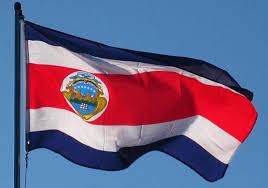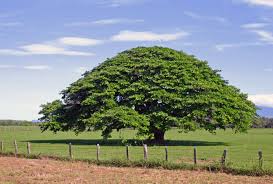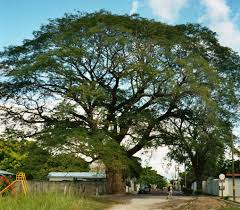 Here in Costa Rica, we have our own version of “Jack and the Beanstalk.” Remember the fairy tale? Jack trades the family cow for magic beans. His angry mother tosses the beans to the ground, and during the night the magic beans sprout into a giant beanstalk. Well, in Costa Rica we have the Guanacaste Tree. It is also in the legume family, and grows to great heights, but not as high as Jack’s bean stalk!
Here in Costa Rica, we have our own version of “Jack and the Beanstalk.” Remember the fairy tale? Jack trades the family cow for magic beans. His angry mother tosses the beans to the ground, and during the night the magic beans sprout into a giant beanstalk. Well, in Costa Rica we have the Guanacaste Tree. It is also in the legume family, and grows to great heights, but not as high as Jack’s bean stalk!

The Guanacaste tree was named Costa Rica’s national tree in 1959, and it is said its shade is symbolic of the governmental protection of its people.

The Guanacaste tree’s scientific name is Enterolobium cyclocarpum and is a tree species from the Fabacease or legume family. It grows abundantly in the Pacific lowland of Costa Rica, particularly (and appropriately named) in the northwestern province of Guanacaste. It thrives in the dry tropical forest despite receiving no rain in the region from December to May.
It is an aesthetically pleasing tree. You will often see it growing as a single tree in a sunny pasture. In that setting, its massive, horizontal limbs emerge low on the trunk and extend to form a wide, spreading crown. If you travel Highway 1 heading to Liberia, you will pass under the cathedral-like arches of the majestic Guanacaste trees lining the road between Puntarenas and Las Juntas. In these more forested areas where there is increased competition for light, trees tend to become taller and branching occurs at a higher level than the solitary specimens in the middle of pastures.

The Guanacaste tree is also known as the “Elephant Ear Tree,” and we are about the find out why. In December–many months after the flowers fall–the first green pods appear high in the crown of the tree. They are ruffled-edge disks with the seeds embedded inside in a radial pattern—resembling, well, an elephant’s ear. The pods reach full maturity in February and as they ripen they turn a dark, glossy brown during March and April. People who live near Guanacaste trees can easily tell when that happens due to the loud cacophony of parrots that feast on the fruit in the afternoons. When fully ripe, the pods fall to the ground below, now moist from the first rains of May. The fallen seedpods cannot germinate unless they are cracked open and the seeds are released, a service which is provided by the hooves of the cattle milling around in the shade. The seedpods serve as food for the cattle and other creatures. Of the remaining seeds, the germination rate is nearly 100%, and seedlings grow rapidly—if not devoured by the field mice. The saplings often reach over one meter in height during their first year. These aggressive reproductive characteristics might be beneficially exploited in reforestation projects. However, the Guanacaste tree roots are strong and expansive and damage nearby structures. So be careful not to plant one near your house or pool!

The Guanacaste tree can grow 120 feet tall with its trunk 6 to 7 feet wide in diameter and can live 70 years. Its bark is light gray, with reddish-brown vertical fissures. The leaves are small and feathery, somewhat resembling those of a North American locust. The tree sheds its leaves during the dry season, exchanging those leaves for spherical clusters of white flowers. Guanacaste flowers are very fragrant, and during intense flowering periods (February to March) their sweet, jasmine-like scent perfumes the air.
The word “Guanacaste” is of Nahuatl origin. It is a combination of 2 words meaning “tree” and “ear”, an allusion to the shape of the tree’s fruit or seedpods.
The seeds are brown and marked with a light brown or orange ring. In Costa Rica, they are used in jewelry making as they are quite beautiful. Green seeds can be boiled and eaten, something I have yet to try. Locals also use the leaves, sap, and bark in traditional folk medicines.
Guanacaste wood is highly prized and widely used in wood-working. The wood is reddish brown in color, lightweight and water-resistant and used to make doors, windows, furniture and even boats! However, you cannot just cut one down to use the wood. The Guanacaste tree is one of many protected species of trees in Costa Rica and permits are needed to cut down even an old dead Guanacaste tree
So, next time you are in Guanacaste take a break in the shade of the sprawling Guanacaste tree—Costa Rica’s giant legume!
Interested in finding a property in Costa Rica? Check out our extensive listings here:
Want to keep up with everything that is happening here in Costa Rica? Join my email list!
Need more information about Costa Rica in general? Read our FAQS about Costa Rica page.
Interested in owning a property in Costa Rica, checkout some great options here
Have a comment or a question? Feel free to EMAIL ME
Like the article? Please share!



